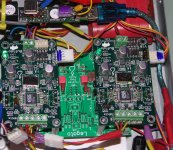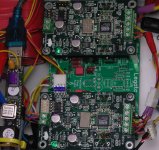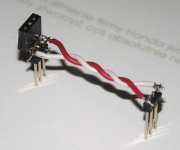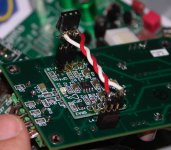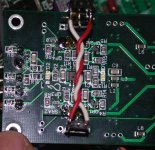Hi
I haven't seen this configuration beffore so I decidet to post this one
Reading Russ posts in Legato vs Ivy thread, he mention that this kind of configuration can be done.... so ...Yes He was right....
Dual Mono Buffalo with single Legato ....
And of cause all 16 DAC are working in 1 chanell ....
I do not have 2 Legato to make any comparisions but this is definetely better than Stereo Buffalo-Legato setup....
So this is the best Buffalo I have heard..now...
Just to make things clear, output from Legato goes to Lundahl Trafos..so no OPAMP mounted.
And there is HiFace with TentLabs Clock .... and I2S taped to Buffalo.
and I2S taped to Buffalo.
I hope some folks will find this setup interesting ....
Rosendorfer
I haven't seen this configuration beffore so I decidet to post this one
Reading Russ posts in Legato vs Ivy thread, he mention that this kind of configuration can be done.... so ...Yes He was right....
Dual Mono Buffalo with single Legato ....
And of cause all 16 DAC are working in 1 chanell ....
I do not have 2 Legato to make any comparisions but this is definetely better than Stereo Buffalo-Legato setup....
So this is the best Buffalo I have heard..now...
Just to make things clear, output from Legato goes to Lundahl Trafos..so no OPAMP mounted.
And there is HiFace with TentLabs Clock ....
I hope some folks will find this setup interesting ....
Rosendorfer
Attachments
Hi
As for transformer Yes I use it for balanced to SE conversion.
Well I'm not saying that this is the best solution but not having any Opamp was very tempting .specilaly after using IVY for some time.... .
.
As for power at the moment I do have one PS for Legato, but I'm working on that..
Best Regards
Rosendorfer
As for transformer Yes I use it for balanced to SE conversion.
Well I'm not saying that this is the best solution but not having any Opamp was very tempting .specilaly after using IVY for some time....
As for power at the moment I do have one PS for Legato, but I'm working on that..
Best Regards
Rosendorfer
Legato power supply: jumpers are soldered there, so only one power supply for both channels, right?
How have you connected both current output legs of each buffalo pcb to one of the legato inputs legs?
Is it just a jumper wire from one buffalo output to the other buffalo output?
Some guys from Japan have made an alternative choice, which is connecting just one current output from buffalo:
I think they were only considering crosstalk, but it does not use half of the ES9018 circuit (I am still wondering if it would not be better to ground such side of the ES9018 with this particular arrangement). ES9018 topology was already made to avoid crosstalk between channels...
With your approach it is possible to sum up all the current outputs.
Would not be better to use two jumper wires with the same length reaching the legato input?
How have you connected both current output legs of each buffalo pcb to one of the legato inputs legs?
Is it just a jumper wire from one buffalo output to the other buffalo output?
Some guys from Japan have made an alternative choice, which is connecting just one current output from buffalo:
(...)
In a main box, he put his SDTrans192, two Buffalo II DAC boards and a Japanese I/V stage.
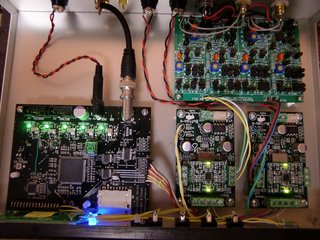

I heard that he was now much enjoying sounds obtained by this system.
I think they were only considering crosstalk, but it does not use half of the ES9018 circuit (I am still wondering if it would not be better to ground such side of the ES9018 with this particular arrangement). ES9018 topology was already made to avoid crosstalk between channels...
With your approach it is possible to sum up all the current outputs.

Would not be better to use two jumper wires with the same length reaching the legato input?
Hi
This is dual mono configuration .... each DAC work for one chanell, but instead using 2 x IVY or 2 x Legato, I'm using 1 Legato and this requires of cause summing up each DAC Right and Left currents/outputs into one Legato Chanell.
Using TP duall mono Volumite firmware L and R DAC chanels are oposite phases so all You need to do is just connect Buffalo L and R outputs but in oposite phases ie : L"+" with R"-" and L"-" with R "+". And this goes into one Legato chanell.
This is the way to get 3dB extra DNR from gooing duall mono...and reach 135dB DNR ..or something close to that .. ..
..
And for better chanell separation of cause separate Power Suplly for L and R Legato chanells would be welcome..
Best Regards
Rosendorfer
This is dual mono configuration .... each DAC work for one chanell, but instead using 2 x IVY or 2 x Legato, I'm using 1 Legato and this requires of cause summing up each DAC Right and Left currents/outputs into one Legato Chanell.
Using TP duall mono Volumite firmware L and R DAC chanels are oposite phases so all You need to do is just connect Buffalo L and R outputs but in oposite phases ie : L"+" with R"-" and L"-" with R "+". And this goes into one Legato chanell.
This is the way to get 3dB extra DNR from gooing duall mono...and reach 135dB DNR ..or something close to that ..
And for better chanell separation of cause separate Power Suplly for L and R Legato chanells would be welcome..
Best Regards
Rosendorfer
Hi
This is dual mono configuration .... each DAC work for one chanell, but instead using 2 x IVY or 2 x Legato, I'm using 1 Legato and this requires of cause summing up each DAC Right and Left currents/outputs into one Legato Chanell.
Using TP duall mono Volumite firmware L and R DAC chanels are oposite phases so all You need to do is just connect Buffalo L and R outputs but in oposite phases ie : L"+" with R"-" and L"-" with R "+". And this goes into one Legato chanell.
This is the way to get 3dB extra DNR from gooing duall mono...and reach 135dB DNR ..or something close to that ....
And for better chanell separation of cause separate Power Suplly for L and R Legato chanells would be welcome..
Best Regards
Rosendorfer
I am planning on doing this eventually, too. But i am still a little confused. In your earlier post you stated that all 16 DAC went to one channel, but each Buffalo II has 8 DAC so that would imply that both Buffalo II boards went to one channel and therefore you are really doing a "quad" or "dual, dual" mono for lack of a better term. Requiring 4 Buffalos IIs and 2 Legato to have two channel output. Or have I missed something.
The Sabre DAC has a total of eight such DAC channels, but
each DAC is actually a balanced pair of the DACs as
described, so there are in effect 16 such DACs. Considerable
flexibility in bit width and channel assignment of the DACs is
provided, but the default configuration is optimum and unless
some special need is found we recommend use of the default
configuration.
Technical Details of the Sabre Audio DAC - Martin Mallinson and Dustin Forman, ESS Technology Technical Staff
A must read white paper.
Some guys from Japan have made an alternative choice, which is connecting just one current output from buffalo:
I think they were only considering crosstalk, but it does not use half of the ES9018 circuit
Shurely he said it does not use all of current outputs at that pic. It was
temporal setting at that time he had not completed I/V boards yet.
The picture After completed:
SDƒJ�[ƒhƒvƒŒƒCƒ„�[“ó�†‹@�i‚»‚Ì‚S�j: Ama Ama Audio Visual

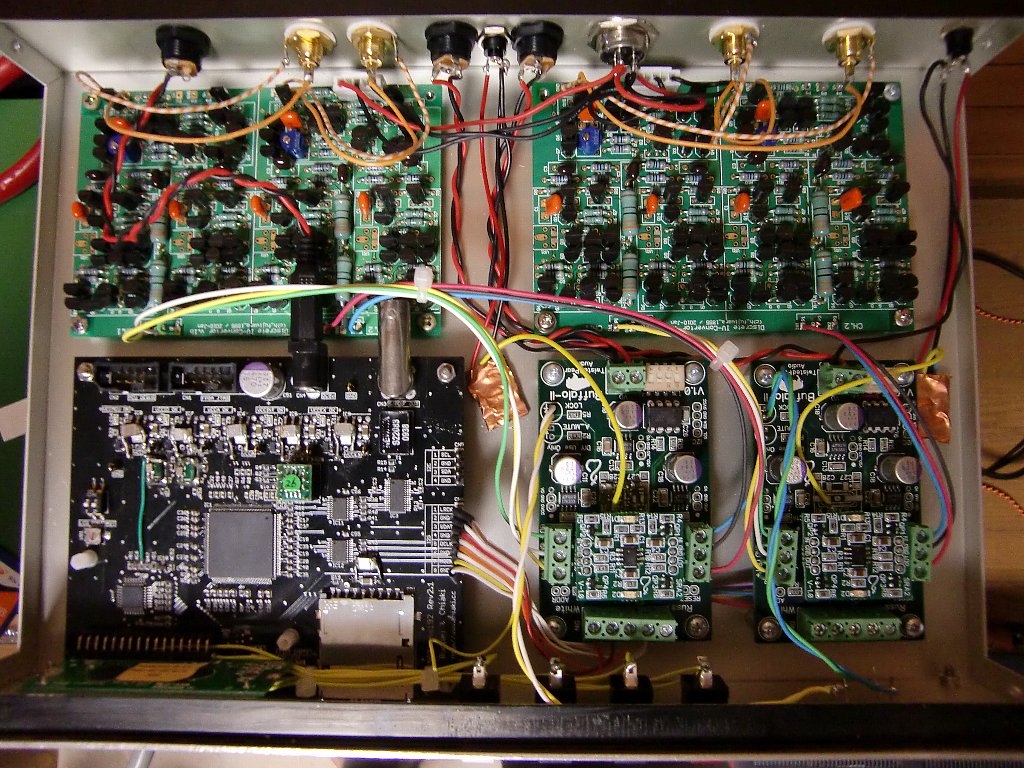
Hi
I haven't seen this configuration beffore so I decidet to post this one
Reading Russ posts in Legato vs Ivy thread, he mention that this kind of configuration can be done.... so ...Yes He was right....
Dual Mono Buffalo with single Legato ....
And of cause all 16 DAC are working in 1 chanell ....
I do not have 2 Legato to make any comparisions but this is definetely better than Stereo Buffalo-Legato setup....
So this is the best Buffalo I have heard..now...
Just to make things clear, output from Legato goes to Lundahl Trafos..so no OPAMP mounted.
And there is HiFace with TentLabs Clock ....and I2S taped to Buffalo.
I hope some folks will find this setup interesting ....
Rosendorfer
Dzien dobry my polish colleague,
Is it possible for you to show a drawing similar to what Twisted Pear has done on their website regarding how the wiring is done for a Dual Mono Buffalo -> Single stereo Legato? Are you paralleling the outputs from the two Buffalo's to the single Legato? And I'm very confused about what you are doing with the negative and positive phases...
Dziekuje bardzo,
Anand.
Thank you.
Is the mentioned I/V stage from Mr. Fujiwara (http://easy-audio-kit.hp.infoseek.co.jp/)?
I saw Mr. Fujiwara´s I/V use the 2SK246BL transistor (http://www20.tok2.com/home/easyaudiokit/IVCmanual.pdf).
Is it DC coupled? Does it have a servo DC? Why two single ended pairs instead of a pair of XLR's?
I think diyaudio is forcing me to learn Japanese, which is not an easy task...
Dzien dobry my polish colleague,
Is it possible for you to show a drawing similar to what Twisted Pear has done on their website regarding how the wiring is done for a Dual Mono Buffalo -> Single stereo Legato? Are you paralleling the outputs from the two Buffalo's to the single Legato? And I'm very confused about what you are doing with the negative and positive phases...
Dziekuje bardzo,
Anand.
x2
Last edited:
>Is the mentioned I/V stage from Mr. Fujiwara (http://easy-audio-kit.hp.infoseek.co.jp/)?
>I saw Mr. Fujiwara´s I/V use the 2SK246BL transistor (http://www20.tok2.com/home/easyaudiokit/IVCmanual.pdf).
Right.
>Is it DC coupled? Does it have a servo DC? Why two single ended pairs >instead of a pair of XLR's?
It does not have servo, but can adjust DC by trimmer pots.
Mr.Fujiwara added DC servo circuit on his "Power-IVC" board,
that's basically the same as above but mainly for higher current output DACs.
I think he uses DIY RCA-XLR compatible cable (two RCA connectors to one XLR)
>I saw Mr. Fujiwara´s I/V use the 2SK246BL transistor (http://www20.tok2.com/home/easyaudiokit/IVCmanual.pdf).
Right.
>Is it DC coupled? Does it have a servo DC? Why two single ended pairs >instead of a pair of XLR's?
It does not have servo, but can adjust DC by trimmer pots.
Mr.Fujiwara added DC servo circuit on his "Power-IVC" board,
that's basically the same as above but mainly for higher current output DACs.
I think he uses DIY RCA-XLR compatible cable (two RCA connectors to one XLR)
Hi
As for drawing this could take bit time but I'm sure that my pictueres will explain everything.
As I've try to explain this is wery easy and straightforward connection. With my "Dual Mono Special Connector" ... I can use oryginall Legato-Bufallo mounting hols and connectors, so no soldering at boards required...
This is very nice and simple solution and it works very well no doubt about this. The only question is if this is better that 2 Bufallo and 2 Legato...
Actualy this is Russ idea so some input from his side would be nice...
One remark if someone is going to try this, Please first check that DAC are really working in duall mono before making output connections...
And to my Polish connections at other side of Atlantic... Anand bardzo dziękuję za miłe przyjęcie .. .
.
If drawing is still needed let me know...
Rosendorfer
As for drawing this could take bit time but I'm sure that my pictueres will explain everything.
As I've try to explain this is wery easy and straightforward connection. With my "Dual Mono Special Connector" ... I can use oryginall Legato-Bufallo mounting hols and connectors, so no soldering at boards required...
This is very nice and simple solution and it works very well no doubt about this. The only question is if this is better that 2 Bufallo and 2 Legato...
Actualy this is Russ idea so some input from his side would be nice...
One remark if someone is going to try this, Please first check that DAC are really working in duall mono before making output connections...
And to my Polish connections at other side of Atlantic... Anand bardzo dziękuję za miłe przyjęcie ..
If drawing is still needed let me know...
Rosendorfer
Attachments
A must read white paper.
Hi Jgazal
It seems You have realy managed to gather some info on Sabre...
Do You have Buffalo in Your hands...??
Best Regards
Rosendorfer
Thanks, Rosendorfer. Those are very enlightening pictures. No need for drawings.
Not yet.
But I am trying to solve this as soon as possible.
I have been following TPA threads for a long time. Russ (TPA), Brian (TPA) and Dustin (from ESS) have posted a lot of knowledge here...
I am not an engineer. In fact, I am a layman, but a very curious layman, which means that I do not have the knowledge and equipment to confirm all data, but I trust their reasoning.
Best regards,
Jose
Do You have Buffalo in Your hands...??
Best Regards
Rosendorfer
Not yet.
But I am trying to solve this as soon as possible.
I have been following TPA threads for a long time. Russ (TPA), Brian (TPA) and Dustin (from ESS) have posted a lot of knowledge here...
I am not an engineer. In fact, I am a layman, but a very curious layman, which means that I do not have the knowledge and equipment to confirm all data, but I trust their reasoning.
Best regards,
Jose
I am planning on doing this eventually, too. But i am still a little confused. In your earlier post you stated that all 16 DAC went to one channel, but each Buffalo II has 8 DAC so that would imply that both Buffalo II boards went to one channel and therefore you are really doing a "quad" or "dual, dual" mono for lack of a better term. Requiring 4 Buffalos IIs and 2 Legato to have two channel output. Or have I missed something.
Hi Jrenkin
I'm sory for any confusion regarding 8 vs 16 Dac at ES9018.
I've checked and officialy ESS is calling this chip as 8 chanell dac so let this be that...
The point is to use one Buffalo Dac per one stereo chanell and summ up all (!!) currents/outputs from Buffalo.... into one Legato input...and if this is 8 or 16 internall dacs this is not so important..
I hope this clears any confusion...
Rosendorfer
Thanks, Rosendorfer. Those are very enlightening pictures. No need for drawings.
I knew You will like them...
BR.
Rosendorfer
Rosendorfer,
Thanks for the pictures. I had to review your first picture on this thread to understand what you have done. I am going to try to explain it in words.
Okay, the assumption is we have two Buffalo II modules and one stereo Legato module.
With the first Buffalo II module, locate the OUT_L outputs. From here connect a wire from the negative pole (-) of the OUT_L output to the positive pole (+) of the OUT_R output. Do the same with the positive (+) pole of the OUT_L output to the negative pole (-) of the OUT_R output. Ideally these two wires should be twisted.
With the second Buffalo II module, locate the OUT_R outputs. From here connect a wire from the negative pole (-) of the OUT_R output to the positive pole (+) of the OUT_L output. Do the same with the positive (+) pole of the OUT_R output and connect a wire to the negative pole (-) of the OUT_L output.
Next, on the Legato board locate the I_IN_L and I_IN_R input holes. You will see there are corresponding holes marked positive (+) and negative (-).
Next, use a 3 terminal connector as shown in Rosendorfer's previous posts so that the OUT_R_OUT+ connects to the corresponding Legato board where it is labelled I_IN_L positive (+) hole. Do the same with the OUT_R_OUT- connects to the corresponding part in the Legato board where it is labelled I_IN_L negative (-) hole.
Do the same thing with the other Buffalo board as above.
So what about the grounds?
Thanks!
Anand.
Thanks for the pictures. I had to review your first picture on this thread to understand what you have done. I am going to try to explain it in words.
Okay, the assumption is we have two Buffalo II modules and one stereo Legato module.
With the first Buffalo II module, locate the OUT_L outputs. From here connect a wire from the negative pole (-) of the OUT_L output to the positive pole (+) of the OUT_R output. Do the same with the positive (+) pole of the OUT_L output to the negative pole (-) of the OUT_R output. Ideally these two wires should be twisted.
With the second Buffalo II module, locate the OUT_R outputs. From here connect a wire from the negative pole (-) of the OUT_R output to the positive pole (+) of the OUT_L output. Do the same with the positive (+) pole of the OUT_R output and connect a wire to the negative pole (-) of the OUT_L output.
Next, on the Legato board locate the I_IN_L and I_IN_R input holes. You will see there are corresponding holes marked positive (+) and negative (-).
Next, use a 3 terminal connector as shown in Rosendorfer's previous posts so that the OUT_R_OUT+ connects to the corresponding Legato board where it is labelled I_IN_L positive (+) hole. Do the same with the OUT_R_OUT- connects to the corresponding part in the Legato board where it is labelled I_IN_L negative (-) hole.
Do the same thing with the other Buffalo board as above.
So what about the grounds?
Thanks!
Anand.
Rosendorfer,
Thanks for the pictures. I had to review your first picture on this thread to understand what you have done. I am going to try to explain it in words.
Okay, the assumption is we have two Buffalo II modules and one stereo Legato module.
With the first Buffalo II module, locate the OUT_L outputs. From here connect a wire from the negative pole (-) of the OUT_L output to the positive pole (+) of the OUT_R output. Do the same with the positive (+) pole of the OUT_L output to the negative pole (-) of the OUT_R output. Ideally these two wires should be twisted.
With the second Buffalo II module, locate the OUT_R outputs. From here connect a wire from the negative pole (-) of the OUT_R output to the positive pole (+) of the OUT_L output. Do the same with the positive (+) pole of the OUT_R output and connect a wire to the negative pole (-) of the OUT_L output.
Next, on the Legato board locate the I_IN_L and I_IN_R input holes. You will see there are corresponding holes marked positive (+) and negative (-).
Next, use a 3 terminal connector as shown in Rosendorfer's previous posts so that the OUT_R_OUT+ connects to the corresponding Legato board where it is labelled I_IN_L positive (+) hole. Do the same with the OUT_R_OUT- connects to the corresponding part in the Legato board where it is labelled I_IN_L negative (-) hole.
Do the same thing with the other Buffalo board as above.
So what about the grounds?
Thanks!
Anand.
As for the grounds they are of cause needed and used.
At Buffalo DAC PCB there is one Ground plane, the same for Left and Right output chanell so there is enought to connect 2 wires between Bufalo outputs. Like on my connector, ground is already at Buffalo PCB. But at connection to Legato You have to use 3 Pin connector with Out+ Out- and Ground in the midle. Exactly as in normall stereo connection.
Hope this is clear.
BR
Rosendorfer
Next question. Since you used 2 Buffalo II modules, obviously the current doubled. What did you end up changing on the Legato module in order to get 1.5V to 2V rms at 0dBfs? It's important to find out what this current is as others who would like to implement a differential I/V stage, whether tubed or solid state or transformer, will need this info to make sure their favorite I/V stage can handle this level of current.
Does anybody know what the current output is of a single buffalo II module?
Thanks,
Anand.
Does anybody know what the current output is of a single buffalo II module?
Thanks,
Anand.
- Status
- This old topic is closed. If you want to reopen this topic, contact a moderator using the "Report Post" button.
- Home
- More Vendors...
- Twisted Pear
- Buffallo Dual Mono 1 Legato
